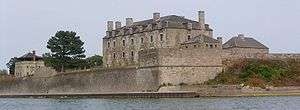Battle of Fort Niagara
| ||||||||||||||||||||||||||||||
The Battle of Fort Niagara was a siege late in the French and Indian War, the North American theatre of the Seven Years' War. The British siege of Fort Niagara in July 1759 was part of a campaign to remove French control of the Great Lakes and Ohio Valley regions, making possible a western invasion of the French province of Canada in conjunction with General James Wolfe's invasion to the east.
Background
British General Jeffrey Amherst made plans for the 1759 military campaigns of the French and Indian War that included an expedition to capture Fort Niagara, a major French military and supply point between the French province of Canada and their forts in the Ohio Valley. Amherst chose Brigadier General John Prideaux to lead the expedition, which also included Sir William Johnson, the British Indian agent who led the expedition's Iroquois forces.
Fort Niagara had been largely constructed under the direction of Captain Pierre Pouchot of the French Army. In early 1759, General Louis-Joseph de Montcalm and New France's Governor, the Marquis de Vaudreuil, sent him with about 2,500 men to fortify Niagara beyond the 500 men that had wintered there. Pouchot, under orders from Vaudreuil, sent many of those men south to Fort Machault in mid-June as part of a plan to reinforce the French forts of the Ohio Country and attack the British at Fort Pitt. The forces left to defend Niagara consisted of about 200 men from the regiments of Royal Roussillon, Languedoc, La Sarre, and Béarn, 20 artillerymen, and about 300 provincial troops and militia.[1]
Prideaux's British Army troops consisted of the 44th and 46th Regiments, and two companies from the 60th, numbering about 2,200 men. He also commanded 2500 provincial militia from New York and 700 from Rhode Island. Delayed by high water on the Mohawk River and the late arrival of some of the provincial companies, the expedition did not begin leaving Schenectady until mid-May. On 27 June the army arrived at Fort Oswego, where they were joined by Johnson and about 600 Iroquois.
Leaving men behind to garrison Oswego, Prideaux departed on 1 July for Niagara with about 3,500 men. While the French had ships patrolling Lake Ontario for British movements, inattention on the part of one the crews allowed the British flotilla to avoid discovery. They arrived at Fort Niagara on 6 July, landed near a marsh out of sight of the fort, and immediately began siege operations.
Siege
The French had about one hundred Iroquois allies at the Fort who deserted when the British arrived. Captain Pouchot directed a vigorous defense.
Prideaux was killed when a shell fragment from one of his own guns hit him, and command of the British forces fell to Sir William Johnson. Johnson was a provincial officer and not in the regular army, and thus there was some question of his right to take command. But Sir William held a royal colonel's commission in his role as commander of the Iroquois auxiliaries, and so he insisted on remaining in command after a lower-ranking regular army officer, Lieutenant Colonel Frederick Haldimand, arrived on the scene.[2]
The French capitulated on 26 July after a French relief force was defeated at the Battle of La Belle-Famille two miles south of the fort.
Aftermath
The capitulation of Fort Niagara occurred on the same day that French troops abandoned Fort Carillon to an overwhelming British army under General Amherst. Fort St. Frédéric was also destroyed as French troops abandoned Lake Champlain to protect the Canadian heartland. Most French forces were at Quebec, where Montcalm was leading the defences against Wolfe's siege. Quebec fell in September 1759, and all of New France was surrendered in September 1760. The remaining French forts in the Ohio and Illinois Country were eventually turned over to British forces.
References
Bibliography
- Dunnigan, Brian Leigh (1996). Siege - 1759, The Campaign against Niagara. ISBN 0-941967-15-8.
- Severance, Frank Hayward (1917). An Old Frontier of France. Dodd, Mead and Company. OCLC 5973820.
